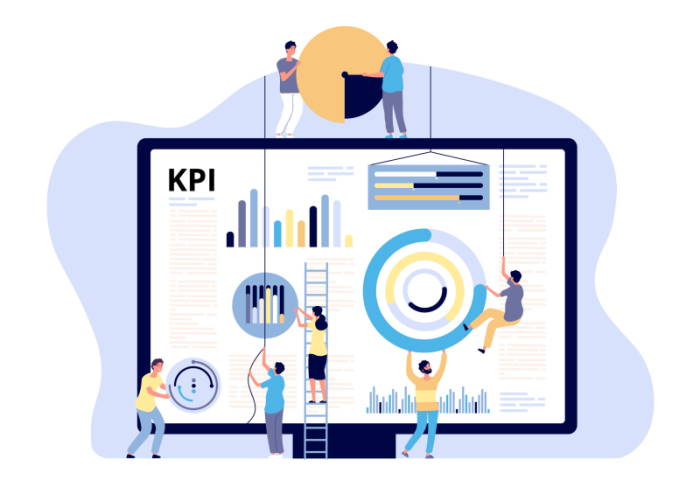In today’s digital age, businesses and marketers are increasingly relying on data-driven strategies to make informed decisions and optimise their efforts. Digital analytics plays a crucial role in this process by providing valuable insights into the performance of your online assets, such as websites, social media channels, and marketing campaigns. By measuring success with digital analytics, you can identify areas for improvement, allocate resources efficiently, and ultimately achieve better results for your business.
There are numerous metrics that can be monitored through digital analytics tools. However, focusing on a few key metrics that directly impact your business goals will help you better understand your performance and make informed decisions. In this article, we will discuss website traffic, engagement, conversion, revenue, customer acquisition, and retention metrics, explaining their importance and providing examples of each.
Traffic Metrics
Traffic metrics measure the number of users who visit your website and the way they interact with it. These metrics provide insight into the effectiveness of your marketing efforts, the popularity of your content, and the overall visibility of your website.
Examples of traffic metrics
- Unique Visitors: The number of distinct users who visit your website during a specific time frame.
- Sessions: The number of individual visits to your website, including multiple visits by the same user.
- Pageviews: The total number of pages viewed by visitors on your website
- Average Session Duration: The average amount of time users spend on your website per session
- Bounce Rate: The percentage of single-page visits where users leave your website without interacting with it further.
How to interpret website traffic data
Interpreting website traffic data involves analysing trends and patterns over time. For instance, an increase in unique visitors and pageviews might indicate that your marketing efforts are successful in attracting more users. However, if your bounce rate is also high, it could suggest that your website content is not engaging enough or that the user experience needs improvement. By identifying these patterns, you can make informed decisions to optimise your website and marketing strategies.
Engagement Metrics
Engagement metrics measure the level of interaction between users and your website or content. These metrics help you understand how effectively your content resonates with your audience and how well it retains their attention.
Examples of engagement metrics
- Pages Per Session: The average number of pages viewed during a single session.
- Average Time on Page: The average amount of time users spend on each page of your website
- Scroll Depth: The percentage of a page’s content that users scroll through.
- Click-Through Rate (CTR): The percentage of users who click on a specific link or call-to-action
- Consumption Rate: The percentage of users who actually consumed your content vs. the number of content views
How to measure user engagement on your website
To measure user engagement, you can use digital analytics tools such as Google Analytics to track the aforementioned metrics. Analysing trends in engagement metrics will help you identify which content is performing well and which needs improvement. For instance, if certain pages have a high average time on page and a low bounce rate, it’s a good indication that users find the content valuable and engaging.
Conversion Metrics
Conversion metrics track the completion of specific actions or goals on your website, such as signing up for a newsletter, making a purchase, or downloading a resource. These metrics help you understand how effectively your website drives desired outcomes and contributes to your business objectives.
Examples of conversion metrics
-
- Conversion Rate: The percentage of users who complete a specific action or goal on your website.
- Goal Completions: The total number of goals completed during a specific time period.
- Funnel Rates: The percentage of users who progress through a series of predetermined steps or actions on your website, ultimately leading to a conversion.
- Abandoned Carts: The number of users who added items to their shopping cart but did not complete the purchase.
How to set up conversion tracking
Setting up conversion tracking involves defining goals within your digital analytics tool, such as Google Analytics. You can create goals for various actions, like form submissions or e-commerce transactions, and assign a value to each goal to measure its impact on your business. Once goals are set up, you can track and analyse the performance of your conversion metrics, identifying areas for improvement and optimisation.
Revenue Metrics
Revenue metrics measure the financial performance of your website or online campaigns. These metrics help you understand the return on investment (ROI) of your marketing efforts and the overall profitability of your online presence.
Examples of revenue metrics
- Revenue: The total income generated from your website or online campaign
- Average Order Value (AOV): The typical amount that customers spend on a transaction
- Revenue per Visitor (RPV): The average revenue generated per visitor to your website
- Return on Ad Spend (ROAS): The revenue from your advertising efforts divided by the overall advertising spend
- Return on Investment (ROI): The revenue generated from your marketing efforts divided by all marketing-related costs
How to measure revenue generated from your website
To measure revenue, integrate your digital analytics tool with your e-commerce platform or payment gateway. This integration will allow you to track financial transactions and generate reports on revenue-related metrics. Analysing these metrics will help you determine the effectiveness of your marketing campaigns and identify opportunities for increasing revenue and ROI.
Customer Acquisition Metrics
Customer acquisition metrics track the efficiency and effectiveness of your marketing efforts in attracting new customers to your website or online business. These metrics provide insight into the cost and performance of your marketing channels, helping you make data-driven decisions to optimise your customer acquisition strategy.
Examples of customer acquisition metrics
-
- Cost per acquisition (CPA): The total cost of acquiring a new customer through a specific marketing channel
- Customer Acquisition Cost (CAC): The overall cost of acquiring a new customer, including marketing and sales expenses
- Channel-Specific Conversion Rates: The conversion rates for each of your marketing channels, such as email, social media, or paid search
- New vs. Returning Visitors: The percentage of new users compared to returning users visiting your website
How to measure the effectiveness of your customer acquisition efforts
To measure customer acquisition metrics, you need to track the performance of your marketing channels using digital analytics tools. Monitor metrics like CPA, CAC, and channel-specific conversion rates to assess the effectiveness of each channel. By analysing these metrics, you can identify the most efficient channels for acquiring new customers and allocate your marketing budget accordingly.
Retention Metrics
Retention metrics measure the ability of your website or online business to retain customers over time. These metrics provide insight into customer satisfaction, loyalty, and the long-term value of your customer base.
Examples of retention metrics to track
-
- Customer Retention Rate: The percentage of customers who continue to make purchases or engage with your website over a specific time period
- Churn Rate: The percentage of customers who stop using your product or service during a specific time period
- Customer Lifetime Value (CLV): The estimated net profit attributed to a customer over the entire duration of their relationship with your business
- Repeat Purchase Rate: The percentage of customers who make multiple purchases from your website or online business
- Repeat User Rate: The percentage of users who make multiple visits to your website or app
How to measure customer retention and loyalty
Measuring customer retention and loyalty involves tracking customer interactions with your website or online business over time. You can use digital analytics tools to monitor retention metrics such as customer retention rate, churn rate, and repeat purchase rate. By analysing these metrics, you can identify trends and patterns in customer behaviour, allowing you to make informed decisions to improve customer satisfaction and loyalty.
For example, if your churn rate is high, it might be worth investigating the reasons behind it, such as poor customer support, product issues, or a lack of engaging content. On the other hand, if your customer retention rate is high, it indicates that your business is successful in maintaining long-term relationships with its customers.
Technical Metrics
Technical metrics are a set of performance indicators that help assess the technical aspects of your website, such as page load speed, site architecture, and mobile responsiveness. These metrics are essential for ensuring a seamless user experience and optimising your website’s performance in search engine rankings.
Examples of technical metrics
-
- Page Load Time: The time it takes for a web page to load completely, including all images, scripts, and other resources
- Time to First Byte (TTFB): The time it takes for a user’s browser to receive the first byte of data from your web server
- Mobile Responsiveness: The ability of your website to adapt its layout and design for optimal viewing and interaction on various mobile devices
- 404 Errors: The number of broken or missing links on your website that result in a “404 Not Found” error message
- Crawl Errors: Errors encountered by search engine crawlers while attempting to access your website, such as server errors or incorrect URL structures
How to measure technical performance
Measuring the technical performance of your website/app ultimately comes down to having the right tools to do so. If you’re just using Google Analytics, you’ll need a pretty sophisticated implementation of it to be able to track errors effectively. Even then, things like page responsiveness, load time, uptime, and javascript issues will still be out of reach. You’ll need to implement more technical focused tools such as New Relic, App Dynamics or DataDog to get a comprehensive of your website/app’s technical performance and monitor the backend issues that could be impacting your user experience.
Closing Thoughts
Digital analytics is the cornerstone of success for any online business, enabling you to make data-driven decisions that propel your business forward. By carefully tracking key metrics such as website traffic, engagement, conversion, revenue, customer acquisition, retention, and technical performance, you’ll gain a comprehensive understanding of your online presence and its impact on your bottom line. By constantly monitoring, analysing, and optimising these metrics, you’ll be well-equipped to adapt to the ever-evolving digital landscape and stay ahead of the competition. Embrace the power of digital analytics to unlock new opportunities for growth and success in your online ventures.
Thank you for taking the time to read our blog post. At Swayven Digital, our mission is to help product and marketing teams take their analytics game to the next level. If you’d like to learn more about our services and how we could assist you. Please don’t hesitate to get in touch with us. Remember, the next level of your analytics journey is just a conversation away.
Stay tuned for more insights, and until next time, keep optimising!





